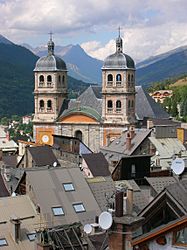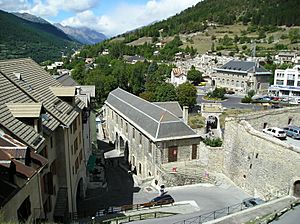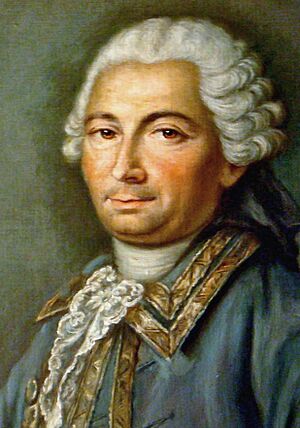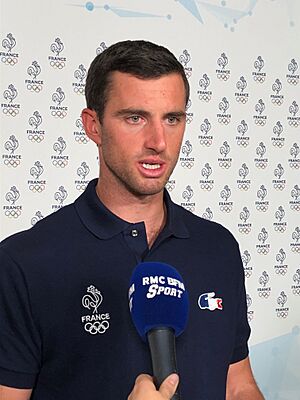Briançon facts for kids
Quick facts for kids
Briançon
|
||
|---|---|---|
|
Subprefecture and commune
|
||

A view of the Collegiate Church of Notre-Dame and Saint-Nicolas
|
||
|
||
| Country | France | |
| Region | Provence-Alpes-Côte d'Azur | |
| Department | Hautes-Alpes | |
| Arrondissement | Briançon | |
| Canton | Briançon-1 and 2 | |
| Intercommunality | Briançonnais | |
| Area
1
|
28.07 km2 (10.84 sq mi) | |
| Time zone | UTC+01:00 (CET) | |
| • Summer (DST) | UTC+02:00 (CEST) | |
| INSEE/Postal code |
05023 /05100
|
|
| Elevation | 1,167–2,540 m (3,829–8,333 ft) | |
| 1 French Land Register data, which excludes lakes, ponds, glaciers > 1 km2 (0.386 sq mi or 247 acres) and river estuaries. | ||
Briançon is a city in southeastern France. It is located in the Hautes-Alpes area, which is part of the Provence-Alpes-Côte d'Azur region. Briançon is known as the highest city in France. It sits at an altitude of 1,326 meters (about 4,350 feet). This measurement is based on cities with more than 2,000 people. In 2018, about 11,084 people lived there.
Since 2008, Briançon has been a UNESCO World Heritage Site. This means its old forts are very important to world history. They are part of the "Fortifications of Vauban."
Contents
History of Briançon
Briançon has a long and interesting history. In Roman times, it was called Brigantium. It was part of the kingdom ruled by Cottius. Brigantium was an important stop on ancient roads. One road led to Vienne and another to Gap. These roads helped connect different parts of ancient Gaul.
Around the 1040s, Briançon became part of the Dauphiné region. This area included not only the Durance valley but also other valleys in the Alps. In 1713, a deal called the Treaty of Utrecht (1713) changed the borders. Some valleys went to Savoy, while Briançon gained the Barcelonnette valley. In 1815, Briançon bravely defended itself for three months against its enemies. This amazing feat is remembered on one of its gates.
Briançon's Population
Here's how Briançon's population has changed over the years:
| Historical population | |||||||||||||||||||||||||||||||||||||||||||||||||||||||||||||||||||||||||||||||||||||||||||||||||||||||||||||||||||
|---|---|---|---|---|---|---|---|---|---|---|---|---|---|---|---|---|---|---|---|---|---|---|---|---|---|---|---|---|---|---|---|---|---|---|---|---|---|---|---|---|---|---|---|---|---|---|---|---|---|---|---|---|---|---|---|---|---|---|---|---|---|---|---|---|---|---|---|---|---|---|---|---|---|---|---|---|---|---|---|---|---|---|---|---|---|---|---|---|---|---|---|---|---|---|---|---|---|---|---|---|---|---|---|---|---|---|---|---|---|---|---|---|---|---|---|
|
|
||||||||||||||||||||||||||||||||||||||||||||||||||||||||||||||||||||||||||||||||||||||||||||||||||||||||||||||||||
| Source: EHESS and INSEE (1968-2017) | |||||||||||||||||||||||||||||||||||||||||||||||||||||||||||||||||||||||||||||||||||||||||||||||||||||||||||||||||||
Geography and Climate
Briançon is very close to the Italian border. It is also part of the Serre Chevalier ski area. The city is built on a high flat area. This area is where the Durance and Guisane rivers meet. Briançon has a train station with connections to other French cities like Paris.
Climate in Briançon
Because it is so high up, Briançon has a special climate. It has warm summers and cold, snowy winters. This type of weather is called a humid continental climate.
| Climate data for Briançon (1981–2005 averages, extremes 1966–2005) | |||||||||||||
|---|---|---|---|---|---|---|---|---|---|---|---|---|---|
| Month | Jan | Feb | Mar | Apr | May | Jun | Jul | Aug | Sep | Oct | Nov | Dec | Year |
| Record high °C (°F) | 17.0 (62.6) |
17.2 (63.0) |
21.4 (70.5) |
22.9 (73.2) |
29.4 (84.9) |
31.8 (89.2) |
34.3 (93.7) |
33.3 (91.9) |
30.2 (86.4) |
27.6 (81.7) |
22.8 (73.0) |
18.3 (64.9) |
34.3 (93.7) |
| Mean daily maximum °C (°F) | 5.0 (41.0) |
5.9 (42.6) |
9.8 (49.6) |
11.6 (52.9) |
16.9 (62.4) |
21.4 (70.5) |
24.8 (76.6) |
24.6 (76.3) |
19.8 (67.6) |
14.4 (57.9) |
8.6 (47.5) |
5.5 (41.9) |
14.1 (57.4) |
| Daily mean °C (°F) | 0.0 (32.0) |
0.6 (33.1) |
4.0 (39.2) |
6.2 (43.2) |
11.0 (51.8) |
14.8 (58.6) |
17.7 (63.9) |
17.5 (63.5) |
13.5 (56.3) |
9.0 (48.2) |
3.8 (38.8) |
1.0 (33.8) |
8.3 (46.9) |
| Mean daily minimum °C (°F) | −5.0 (23.0) |
−5.0 (23.0) |
−1.7 (28.9) |
0.9 (33.6) |
5.2 (41.4) |
8.1 (46.6) |
10.5 (50.9) |
10.4 (50.7) |
7.2 (45.0) |
3.7 (38.7) |
−1.0 (30.2) |
−3.6 (25.5) |
2.6 (36.7) |
| Record low °C (°F) | −17.9 (−0.2) |
−17.4 (0.7) |
−18.4 (−1.1) |
−10.7 (12.7) |
−5.7 (21.7) |
−0.2 (31.6) |
2.4 (36.3) |
1.4 (34.5) |
−4.0 (24.8) |
−8.1 (17.4) |
−12.5 (9.5) |
−16.9 (1.6) |
−18.4 (−1.1) |
| Average precipitation mm (inches) | 58.5 (2.30) |
39.3 (1.55) |
46.8 (1.84) |
71.3 (2.81) |
67.3 (2.65) |
68.9 (2.71) |
51.5 (2.03) |
54.4 (2.14) |
72.0 (2.83) |
99.0 (3.90) |
69.9 (2.75) |
60.2 (2.37) |
759.1 (29.89) |
| Average precipitation days (≥ 1.0 mm) | 6.9 | 5.2 | 5.8 | 8.6 | 9.4 | 8.7 | 6.9 | 6.9 | 6.8 | 9.6 | 7.0 | 7.2 | 89.0 |
| Mean monthly sunshine hours | 149.7 | 164.8 | 207.4 | 180.9 | 207.6 | 232.7 | 253.7 | 230.1 | 192.2 | 156.6 | 130.8 | 126.2 | 2,232.6 |
| Source: Meteo France | |||||||||||||
Famous Sights

Briançon has a very old and strong fortress. It was built in the 1600s by a military engineer named Vauban. He designed it to protect the area. The streets inside the old town are very steep and narrow, but they are also quite beautiful. Briançon is at the bottom of a pass called the Col de Montgenèvre. This pass leads to Turin, Italy. Because of this, many other forts were built on the hills around Briançon. For example, Fort Janus is 1,200 meters (about 3,900 feet) above the town!
The main church in Briançon was built between 1703 and 1726. It has two tall towers and stands out clearly.
The Pont d'Asfeld is a bridge east of the town. It was built in 1734. This bridge has a single arch that spans 40 meters (130 feet). It crosses the Durance river at a height of 56 meters (184 feet).
The newer part of Briançon is in the flat area below the old town. It is called Ste Catherine. Briançon is also close to the Parc National des Ecrins and the Vallée de la Clarée. These are beautiful natural areas.
On July 8, 2008, several buildings in Briançon became World Heritage Sites by UNESCO. This means they are very important to the world's history and culture. These buildings include:
- The city walls
- Redoute des Salettes
- Fort des Trois-Têtes
- Fort du Randouillet
- Ouvrage de la communication Y
- The Asfeld Bridge
These structures were designed by Sébastien Le Prestre de Vauban. He was a military engineer for King Louis XIV. Other fortified sites in France, like Mont-Dauphin, are also part of this UNESCO group.
Notable People from Briançon
Many interesting people were born in Briançon or lived there.
- Aymon de Briançon (died 1211) was a monk and an Archbishop.
- Oronce Finé (1494–1555) was a mathematician and mapmaker.
- Jean-Antoine Morand (1727–1794) was an architect and city planner.
- Augustin Chenu (1833–1875) was a painter known for his landscapes.
- Albert Achard (1894–1972) was a famous pilot in World War I.
- Emilie Carles (1900–1979) was a French writer and activist.
- Frédérique Lucien (born 1960) is an artist who works with drawing, painting, and ceramics.
- Jean-Christophe Keck (born 1964) is a music expert and conductor.
- Xavier Mortimer (born 1980) is a magician who performs in Las Vegas.
Sports Stars
- Jules Melquiond (born 1941) is an Alpine ski racer.
- Henry Bréchu (born 1947) is also an Alpine ski racer.
- Luc Alphand (born 1965) was an Alpine ski racer and now races cars.
- Benjamin Melquiond (born 1975) is an Alpine ski racer.
- Nicolas Bonnet (born 1984) is a ski mountaineer and runner.
- Pierre Vaultier (born 1987) won two gold medals in snowboard cross at the Winter Olympics.
- Laure Barthélémy (born 1988) is a cross-country skier.
- Richard Jouve (born 1994) is a cross-country skier who won two team bronze medals at the Olympics.
International Connections
Briançon is connected to other cities around the world. It is "twinned" with:
Sports in Briançon
Briançon is a great place for sports, especially outdoor activities.
Cycling
Briançon is a very popular spot for cycling. It has often been a starting or finishing point for stages of the Tour de France. This is one of the world's most famous bike races. Since 1947, the Tour de France has started or finished in Briançon many times. This makes it a favorite place for cyclists to visit.
In 2007, a stage of the Tour de France ended in Briançon. Cyclists rode 159.5 kilometers (about 99 miles). They crossed high mountain passes like the Col de l'Iseran and the Col du Galibier.
Ice Hockey
Briançon has a professional ice hockey team called the Diables Rouges de Briançon. They play in the Ligue Magnus, which is the top league in France.
Kayaking
Briançon is located where the Durance and Guisane rivers meet. These rivers are fed by melting snow in the spring. This creates exciting whitewater conditions. Tourists from all over Europe come here to kayak and raft. They enjoy the fast-moving rivers and their smaller streams. The best time for whitewater sports is in early summer. This is when the snow and glaciers are melting.
Skiing
Briançon is the main town for the large Serre Chevalier ski resort. It is the lowest point of the resort. Many buildings in Briançon are used by visitors during the winter. The city's population can triple during the ski season!
See also
 In Spanish: Brianzón para niños
In Spanish: Brianzón para niños







